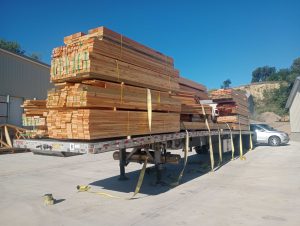If you didn’t read the last two days’ blogs, Part I and II of a three part series on how to design a woodworking shop, I’d advise you to back up a day or two and read them.
To finish up on how to best design your woodworking shop…
Design your building with adequate electric service. Look at the amperage ratings of the power tools to determine electric power needs. Don’t under design and be tripping circuit breakers with the power tools. Even the slightest bit uncomfortable with the idea of doing electrical wiring? DON’T DO IT. Hire a licensed electrician to do the work. They don’t work cheap, but having a pro doing the work is certainly a value considering the alternatives. Like being electrocuted or burning the place down.
Adequate lighting is absolutely essential in any shop. Operating power tools in a dimly-lit area is a really bad idea. Not to mention the eye strain and headaches from having to squint at work with insufficient light. Get some 4-foot fluorescent fixtures and connect them to a circuit which is not being used to power tools. This way, if a breaker trips from the table saw, it eliminates standing there in the dark with a still-spinning blade somewhere, which is slowly coasting to a stop. Set lights up in locations so they don’t glare into eyes. And again, with anything involving wiring — hire out the work if you don’t feel competent.
In a cold climate, consider some means of heating your woodworking shop. There are myriad choices  available, and each type of energy has its pros and cons for cost, efficiency, etc. Choices include electric heat, natural gas, propane, kerosene, wood-burning stoves, even units fueled by corn and pellets. Keep in mind many of these heaters will need proper ventilation, and may require some extensive installation procedures. Setting up gas-fired heaters is not for the faint-at-heart. Consider having an installer do it. Be cautious in choosing a location for heaters — especially in the close confines of a small shop. Keep it away from combustibles.
available, and each type of energy has its pros and cons for cost, efficiency, etc. Choices include electric heat, natural gas, propane, kerosene, wood-burning stoves, even units fueled by corn and pellets. Keep in mind many of these heaters will need proper ventilation, and may require some extensive installation procedures. Setting up gas-fired heaters is not for the faint-at-heart. Consider having an installer do it. Be cautious in choosing a location for heaters — especially in the close confines of a small shop. Keep it away from combustibles.
Think personal safety! Protect lungs by using a dust collector to remove most of the dust at the sources. There are small models designed with the small wood shop in mind. At the very least, use a shop vacuum to connect to power tools.
Be sure to wear an approved respirator when cutting, sanding, or milling wood, and when working with solvents and finishes. Eye protection is essential too. Choose a good pair of goggles or better yet, a face shield. And don’t forget ear plugs or ear muffs to protect hearing from the noise of machinery.
Don’t let the shop get too crowded. An overly cluttered woodworking shop can be fraught with dangers from tripping and running into things. Maintain a pathway so a quick exit is available if an emergency arises. An unclean shop can present fire hazards from dust and debris. Keep combustibles such as finishes, solvents and adhesives stored in tight containers inside a cabinet located away from heat sources. Properly dispose of oily and solvent-soaked rags. The best way is to put them in an airtight metal safety can, or a clean 1-gallon paint can with some water inside and a tight lid. Empty these cans daily.
Keep a good first aid kit on hand and located in an accessible place. While this is not an exhaustive list, at least have adhesive bandages of different sizes, gauze, antibiotic ointment, wrapping tape, tourniquet, a fine-tipped tweezers (for extracting splinters), eye wash cup and a bottle of clean water. Keep first aid items in a sealed container, to minimize contamination.
And don’t forget to have a good, approved fire extinguisher. Make sure it is designed to work on all three of the common types of fires (A-B-C). Mount it on the wall where it can be quickly gotten to, and keep it maintained.
This three part series on woodworking shops is not meant to be exhaustive, but will get you well on the road to really thinking out your shop design…before you build it. And even if you want to do some major re-organization of a shop you already own, it never hurts to “start over” by laying out a plan on paper. I don’t know about you, but when my shop is clean, organized and set up properly, it almost “calls to me” to happily work on my projects. If you have other “clever” or helpful ideas for storage and use of a woodworking shop, don’t hesitate to let me know. Happy woodworking~!






